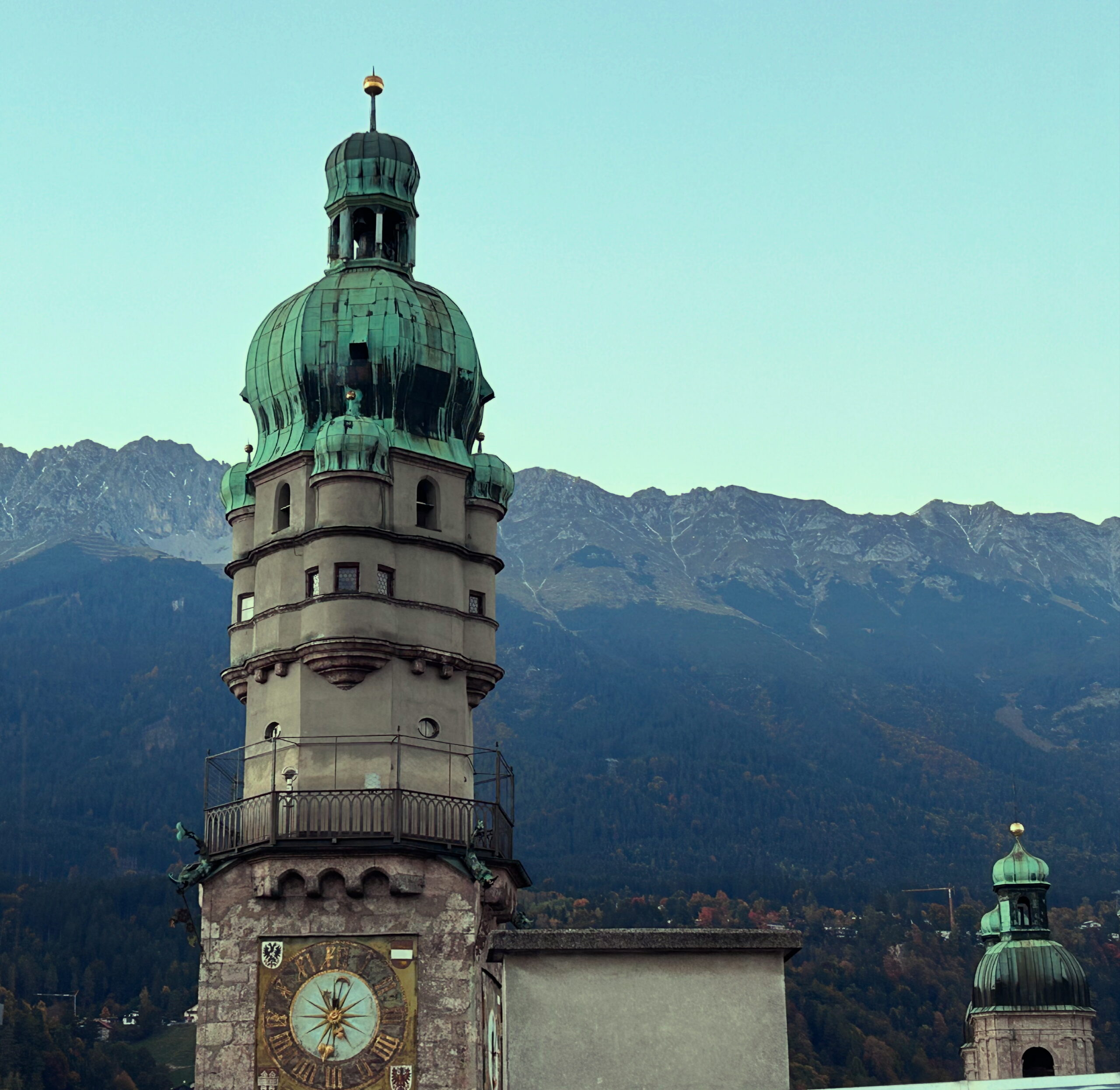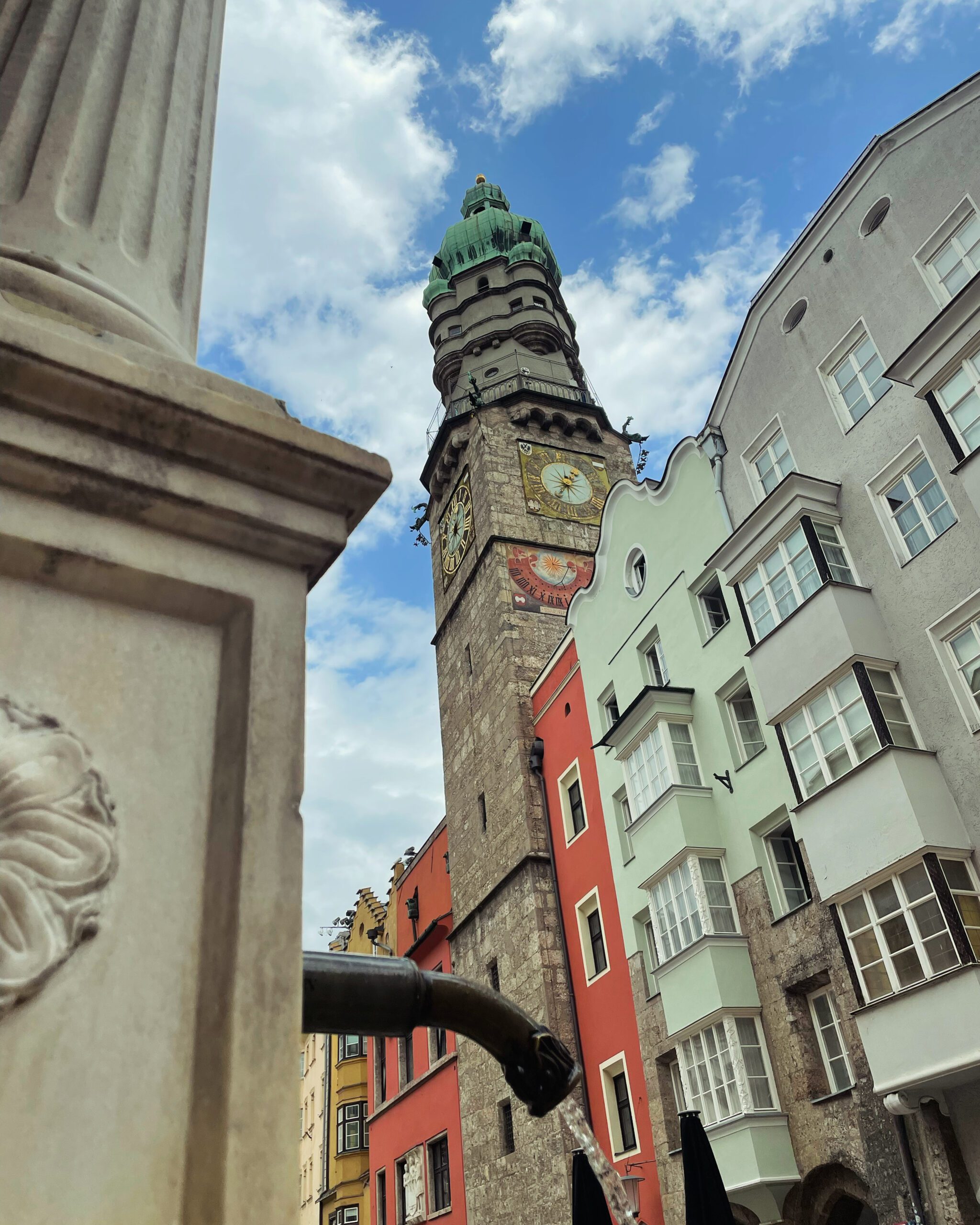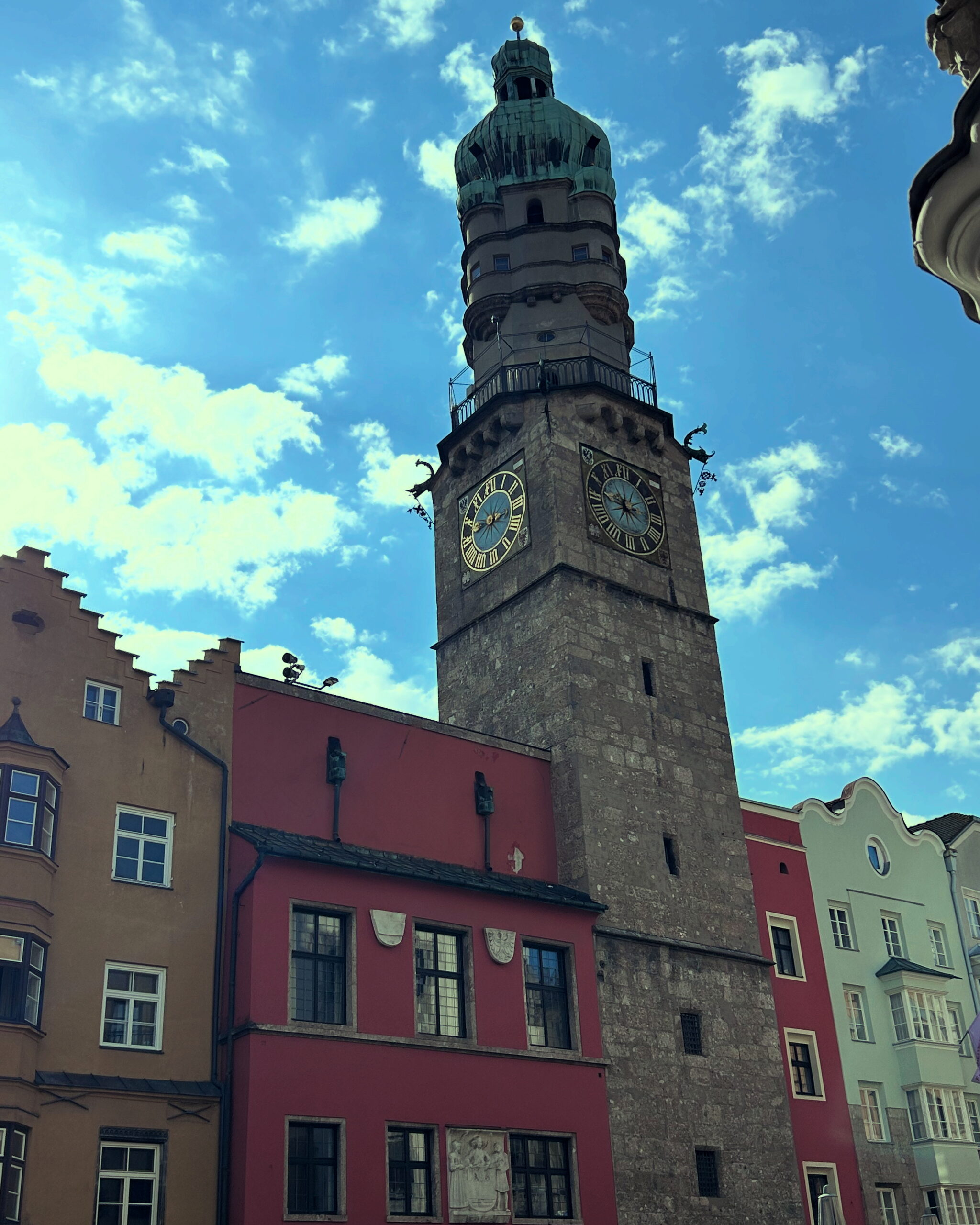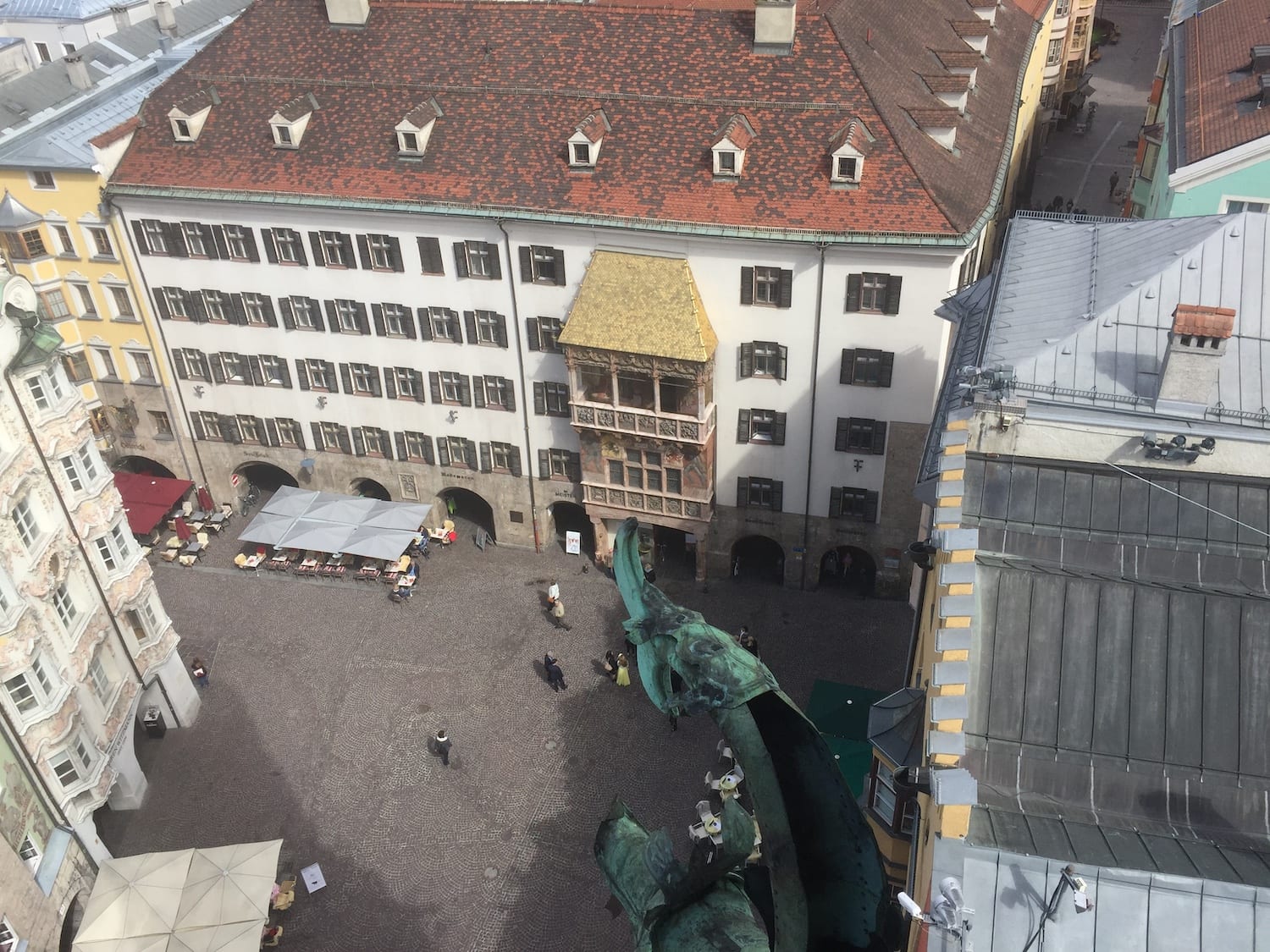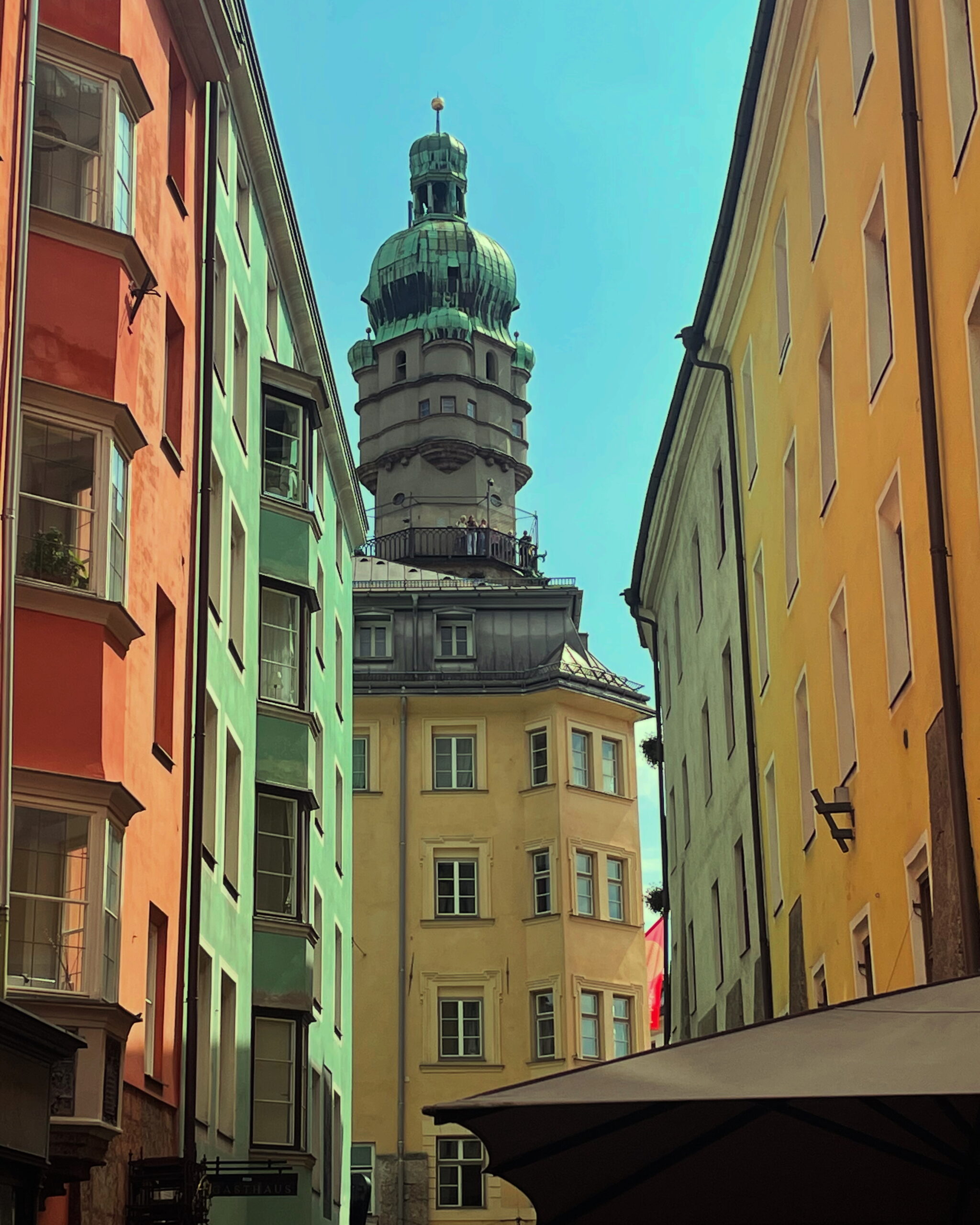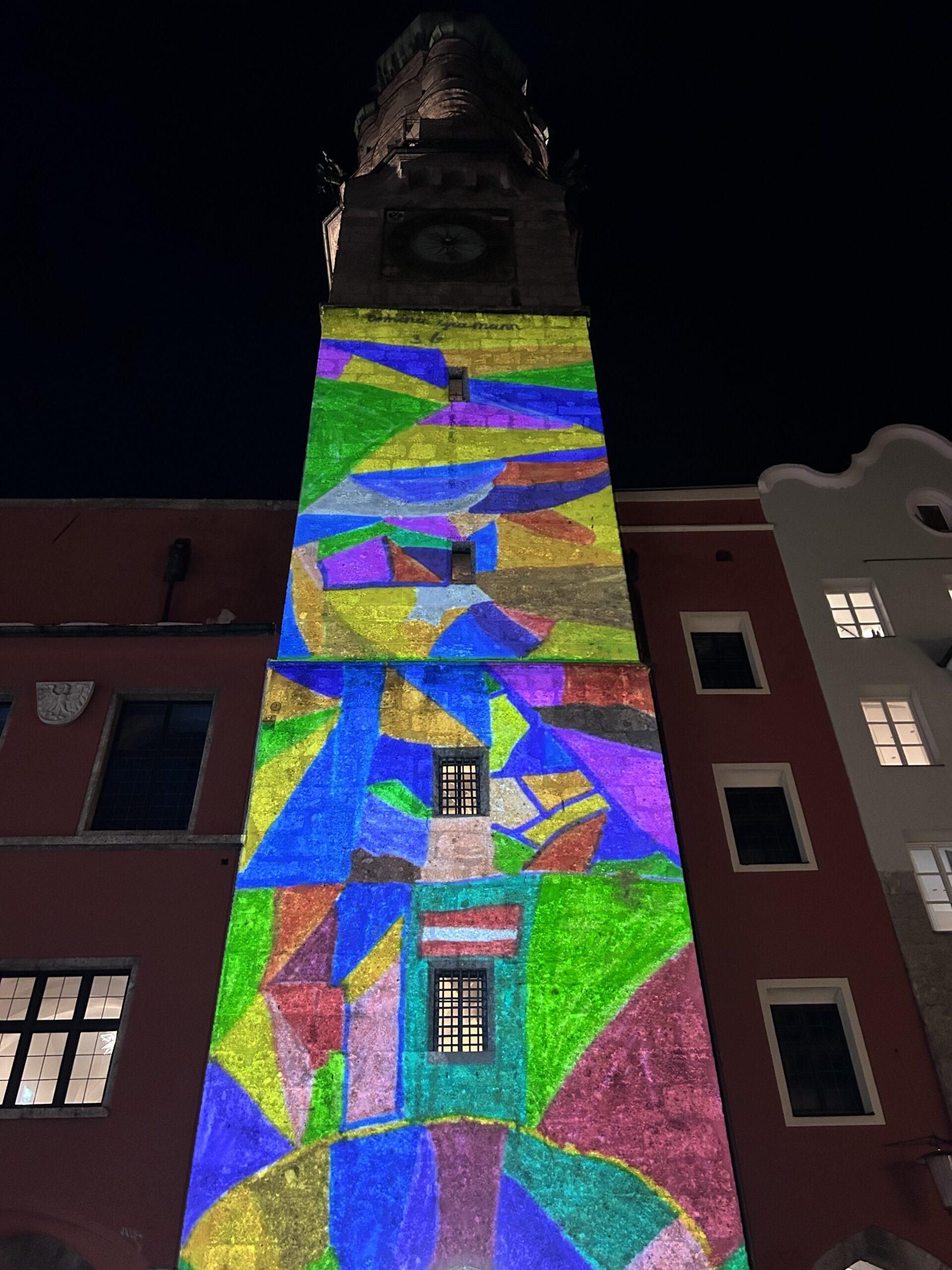City tower & old town hall
Herzog-Friedrich-Straße 21
Worth knowing
The red building flanking the City Tower is the Old Town Hall. Until the 14th century, the city’s affairs were managed in the house of the town judge or mayor. Besides a lack of transparency, these were not ideal working conditions for governing an ever-growing municipality with its own city council. Duke Ludwig of Brandenburg imposed a special tax to finance the construction of a dedicated town hall. In 1358, the building on the Upper Town Square was completed. It was the first official town hall of a Tyrolean municipality. The mayor and the community now had an appropriate home as official bodies. The modest building was erected before Innsbruck’s golden age and was not intended to display bourgeois splendour but to serve as an administrative building. The market inspectors were also based in the town hall. They oversaw the goods offered, their quantity and quality. Bread, for example, was weighed by the “bread guardian” at the bread counter in the town hall to prevent extortion and fraud. Through several renovations, extensions and repairs—the earthquake of 1689 did not spare the town hall—the building took on its present form. A relief on the façade commemorates the confirmation of city rights in 1239. The plaque was added in 1939 for the 700th anniversary of this event, based on a design by Hans Andre. Despite the anti-clerical stance of the National Socialists, the church painter Andre managed to incorporate an angel as the herald of city rights. The costumes of the figures depicted do not reflect the actual fashion of Innsbruck’s bourgeoisie in the 13th century but rather what was considered the German ideal of the German city of Innsbruck at the dawn of National Socialism.
The symbolic sign of civic pride in city rights came later. The City Tower was built between 1442 and 1450 during the reign of Frederick IV. Innsbruck had meanwhile become a residence city. The increasingly wealthy citizens of Innsbruck wanted to demonstrate their newfound confidence. In 1560, the sturdy tower was crowned with an onion dome, the so-called Augsburg cap. This style was highly fashionable at the time, as Augsburg—home and business city of the merchant family Jakob Fugger—was one of Europe’s most important cities. Below the dome, skilfully crafted copper gargoyles in the shape of dolphins cluster. However, the City Tower was not merely an expression of Innsbruck’s vanity. The first floor housed a prison, and from the platform above, the tower watchman had to keep an eye out for dangers, monitor the city and, above all, sound the alarm in case of fire. Another duty of the watchman was announcing the time. Unlike today, not every citizen had a wristwatch. Besides church bells, people relied on the goodwill and precision of the man in the tower. A peculiarity of time in the Middle Ages was that it differed from village to village. Innsbruck likely had a different time than Hall or Schwaz. Only with industrialisation and the railway did synchronised time become important. Work schedules and timetables made a reinvention of time necessary.
Die Erweiterung des Alten Rathauses innerhalb der Altstadt schlug trotz mehrerer Entwurfsversuche im Laufe der zweiten Hälfte des 19. Jahrhunderts mangels Platzes fehl. Heute ist der Stadtturm beliebt, um die Altstadt von oben zu betrachten. In 55 m Höhe kann man sich wie ein mittelalterlicher Turmwächter fühlen und die ganze Altstadt überblicken. Besonders der Blick auf Helblinghaus und Goldenes Dachl mit der Nordkette im Hintergrund bildet die Kulisse für das ganz besondere Foto. Ob es gut bei den anderen Besuchern ankommt, wenn man lauthals die Uhrzeit von seinem Handy abliest, ist eine andere Frage.
Big City Life in early Innsbruck
Innsbruck hatte sich von einem römischen Castell während des Mittelalters zu einer Stadt entwickelt. Diese formale Anerkennung Innsbrucks als Stadt durch den Landesfürsten brachte ein gänzlich neues System für die Bürger mit sich. Marktrecht, Baurecht, Zollrecht und eine eigene Gerichtsbarkeit gingen nach und nach auf die Stadt über. Stadtbürger unterlagen nicht mehr ihrem Grundherrn, sondern der städtischen Gerichtsbarkeit, zumindest innerhalb der Stadtmauern. Das geflügelte Wort "Stadtluft macht frei" rührt daher, dass man nach einem Jahr in der Stadt von allen Verbindlichkeiten seines ehemaligen Grundherrn frei war. Bürger konnten anders als unfreie Bauern und Dienstleute frei über ihren Besitz und ihre Lebensführung verfügen. Natürlich hatten sie Rechte und Pflichten zu erfüllen. Bürger lieferten zwar keinen Zehent ab, sondern bezahlten Steuern an die Stadt. Welche Gruppe innerhalb der Stadt welche Steuer zu bezahlen hatte, konnte die Stadtregierung selbst festlegen. Die Stadt wiederum musste diese Steuern nicht direkt abliefern, sondern konnte nach Abzug einer fixen Abgabe an den Landesfürsten frei über ihr Budget verfügen. Zu den Ausgaben neben der Stadtverteidigung gehörte die Kranken- und Armenfürsorge. Notleidende Bürger konnten in der „Boiling kitchen“ Speisen beziehen, so sie das Bürgerrecht hatten. Besondere Beachtung schenkte die Stadtregierung ansteckenden Krankheiten wie der Pest, die in regelmäßigen Abständen die Einwohner marterte.
In return for their rights, every citizen had to take the oath of citizenship. This civic oath included the obligation to pay taxes and perform military service. In addition to defending the town, the citizens were also deployed outside the town. In 1406, a delegation together with mercenaries opposed an Appenzell army in defence of the Upper Inn Valley. From 1511, according to Emperor Maximilian's Landlibell, the town council was also obliged to provide a contingent of conscripts for the defence of the country. In addition to this, there were volunteers who Freifähnlein For example, during the Turkish siege of Vienna in 1529, Innsbruckers were among the city's defenders.
Im 15. Jahrhundert wurde der Platz eng im rasch wachsenden Innsbruck. Das Bürgerrecht wurde zu einem exklusiven Gut. Nur noch freien Untertanen aus ehelicher Geburt war es möglich, das Stadtrecht zu erlangen. Um Bürger zu werden, mussten entweder Hausbesitz oder Fähigkeiten in einem Handwerk nachgewiesen werden, an der die Zünfte der Stadt interessiert waren. Der Streit darum, wer ein „echter“ Innsbrucker ist, und wer nicht, hält sich bis heute. Dass Migration und Austausch mit anderen immer schon die Garantie für Wohlstand waren und Innsbruck zu der lebenswerten Stadt gemacht haben, die sie heute ist, wird dabei oft vergessen.
Due to these restrictions, Innsbruck had a completely different social composition to the neighbouring villages. Craftsmen, merchants, civil servants and servants of the court dominated the cityscape. Merchants were often travelling people, officials and court servants also came to Innsbruck for a short time as part of a prince's entourage and did not have citizenship. It was the craftsmen who exercised a large part of the political power within the citizenry. Unlike peasants, they belonged to the mobile classes in the Middle Ages and early modern period. After their apprenticeship, they went to the Walzbefore they took the master craftsman's examination and either returned home or settled in another city. Craftsmen not only transferred knowledge, they also spread cultural, social and political ideas. The craft guilds sometimes exercised their own jurisdiction alongside the municipal jurisdiction among their members. They were social structures within the city structure that had a great influence on politics. Wages, prices and social life were regulated by the guilds under the supervision of the sovereign. One could speak of an early social partnership, as the guilds also provided social security for their members in the event of illness or occupational disability. Individual trades such as locksmiths, tanners, platers, carpenters, bakers, butchers and blacksmiths each had their own guild, headed by a master craftsman.
From the 14th century, Innsbruck demonstrably had a city council, the so-called Gemainand a mayor who was elected annually by the citizens. These were not secret but public elections, which were held every year around Christmas time. In the Innsbrucker Geschichtsalmanach von 1948 findet man Aufzeichnungen über die Wahl des Jahres 1598.
The Feast of St. Erhard, i.e., January 8th, played a significant role in the lives of the citizens of Innsbruck each year. On this day, they gathered to elect the city officials, namely the mayor, city judge, public orator, and the twelve-member council. A detailed account of the election process between 1598 and 1607 is provided by a protocol preserved in the city archive: "... The ringing of the great bell summoned the council and the citizenry to the town hall, and once the honorable council and the entire community were assembled at the town hall, the honorable council first convened in the council chamber and heard the farewell of the outgoing mayor of the previous year, Augustin Tauscher."
Der Bürgermeister vertrat die Stadt gegenüber den anderen Ständen und dem Landesfürsten, der die Oberherrschaft über die Stadt je nach Epoche mal mehr, mal weniger intensiv ausübte. Jeder Stadtrat hatte eigene, klar zugeteilte Aufgaben zu erfüllen wie die Überwachung des Marktrechts, die Betreuung des Spitals und der Armenfürsorge oder die für Innsbruck besonders wichtige Zollordnung. Der Konsum von Alkohol und das Verweilen in den Gaststätten war zu verschiedenen Zeiten unterschiedlich geregelt. Ärmeren Bevölkerungsschichten war es nicht nur zu teuer, sie durften auch nur zu gewissen Zeiten in die Gasthäuser. So sollte übermäßiger Trunkenheit und dem Anbetteln der Oberschicht vorgebeugt werden. Der Stadtrat kontrollierte die Qualität und Güte der Speisen ähnlich einem frühen Marktamt, waren Städte doch an der Qualität ihrer Betriebe interessiert, um als Wirtschaftsstandort und für Gäste interessant zu sein. Bei all diesen politischen Vorgängen sollte man sich stets in Erinnerung rufen, dass Innsbruck im 16. Jahrhundert etwa 5000 Einwohner hatte, von denen nur ein kleiner Teil das Bürgerrecht besaß. Besitzlose, fahrendes Volk, Erwerbslose, Dienstboten, Diplomaten, Angestellte, Frauen und Studenten waren keine wahlberechtigten Bürger. Zu wählen war ein Privileg der männlichen Oberschicht.
Contrary to popular belief, the Middle Ages were not a lawless time of arbitrariness. At both local and national level, there were codes that regulated very precisely what was permitted and what was forbidden. This could vary greatly depending on the ruler and the prevailing morals and customs. Carrying weapons, swearing, prostitution, making noise, playing music, blasphemy, children playing - anything and anyone could be targeted by the guardians of the law. If you include the rules for trade, customs duties, the exercise of professions by guilds and price fixing for all kinds of goods by the magistrate, pre-modern and early modern coexistence was no less regulated than it is today. The difference was control and enforcement power, which the authorities often lacked.
If someone was caught committing an unlawful or immoral act, there were courts that passed judgement. The medieval court days were held at the "Dingstätte" is held outdoors. The tradition of the Thing goes back to the old Germanic Thingwhere all free men gathered to dispense justice. The city council appointed a judge who was responsible for all offences that were not subject to the blood court. He was assisted by a panel of several jurors. Punishments ranged from fines to pillorying and imprisonment. The city also monitored compliance with religious order. "Heretics" and dissenters were not reprimanded by the church, but by the city government.
The penal system also included less humane methods than are common today, but torture was not used indiscriminately and arbitrarily. However, torture was also regulated as part of the procedure in particularly serious cases. Until the 17th century, suspects and criminals in Innsbruck were Kräuterturm at the south-east corner of the city wall, on what is now Herzog-Otto-Ufer. Both the trial and the serving of the sentence were public trials. The city tower was Fool's cottagea cage in which people were locked up and put on display. On the wooden Schandesel you were dragged through the town for minor offences. The pillory was located in the suburb, today's Maria-Theresien-Straße. There was no police force, but the town magistrate employed servants and town watchmen were posted at the town gates to keep the peace. It was a civic duty to help catch criminals. Vigilante justice was forbidden.
The responsibilities between municipal and manorial justice had been regulated in the Urbarbuch since 1288. The provincial court still had jurisdiction over serious offences. Crimes such as theft, murder and arson were subject to this blood law. The provincial court for all municipalities south of the Inn between Ampass and Götzens was located on the Sonnenburgwhich was located to the south above Innsbruck. In the 14th century, the Sonnenburg district court moved to the upper town square in front of the Innsbruck city tower, later to the town hall and in the early modern period to Götzens. With the centralisation of the law in the 18th century, the court moved to Götzens. Sonnenburg back to Innsbruck and was housed under different names and in different buildings such as the Leuthaus in Wilten, on the Innrain or at the Ettnau residence, known as the Malfatti Castlein the Höttinger Gasse.
From the late 15th century, Innsbruck's executioner was centralised and responsible for several courts and was based in Hall. The execution centres were located in several places over the years. For a long time, there was a gallows on a hill in today's Dreiheiligen district, right next to the main road. The Köpflplatz was located until 1731 at today's corner of Fallbachgasse / Weiherburggasse in Anpruggen. In Hötting stand der Galgen hinter der Kapelle zum Großen Gott. Die heutige Kapelle, die neben dem barocken Kruzifix Keramikfiguren des bekannten Künstlers Max Spielmann (1906 – 1984) trägt, wurde bei Straßenarbeiten in den 1960er Jahren versetzt. Während Spielmanns Denkmal Totentanz an die Gefallenen des Zweiten Weltkriegs erinnert, konnten zum Tode Verurteilte am letzten Weg hier ein letztes Gebet zum Himmel schicken, bevor ihnen der Strick um den Hals gelegt oder der Kopf abgeschlagen wurde, je nach gesellschaftlichem Status und Art des Verbrechens. Es war nicht unüblich, dass der Verurteilte seinem Henker eine Art Trinkgeld zusteckte, damit sich dieser bemühte, möglichst genau zu zielen, um so die Hinrichtung so schmerzlos wie möglich zu gestalten. Viel konnte schiefgehen. Traf das Schwert nicht genau, wurde die Schlinge nicht sorgfältig umgelegt oder riss gar das Seil, erhöhte sich das Leiden des Verurteilten. Für die Obrigkeit und öffentliche Ordnung besonders schädliche Delinquenten wie der „Ketzer“ Jakob Hutter oder die gefassten Anführer der Bauernaufstände von 1525 und 1526 wurden vor dem Goldenen Dachl executed in a manner suitable for the public. "Embarrassing" punishments such as quartering or wheeling, from the Latin word poena were not the order of the day, but could be ordered in special cases. Executions were a demonstration of power by the authorities and were public. It was seen as a way of cleansing society of criminals and was intended to serve as a deterrent. Large crowds gathered to accompany the gallows bird on its final journey. Classes at the university were suspended on execution days to allow students to attend and purify them. The bodies of the executed were often left hanging and buried outside the consecrated area of the cemeteries or given to the university for study purposes. The last public execution in Austrian history took place in 1868. Even then, people were not squeamish, but the killings on the stranglehold, which was the method of choice for executions until the 1950s, were no longer a spectacle in front of an audience.
With the centralisation of law under Maria Theresa and Joseph II in the 18th century and the General Civil Code in the 19th century under Franz I, the law passed from cities and sovereigns to the monarch and their administrative bodies at various levels. Torture was abolished. The Enlightenment had fundamentally changed the concept of law, punishment and rehabilitation. The collection of taxes was also centralised, which resulted in a great loss of importance for the local nobility and an increase in the status of the civil service. With the increasing centralisation under Maria Theresa and Joseph II, taxes and customs duties were also gradually centralised and collected by the Imperial Court Chamber. As a result, Innsbruck, like many municipalities at the time, lost a large amount of revenue, which was only partially offset by equalisation.
Innsbruck - city of bureaucrats and civil servants
Innsbruck is proud of its many titles. University city, Austria's capital of sport or home to the world's best hospital. If you take a look at the list of the region's largest employers or at its history, Innsbruck is one thing above all: a city of civil servants. The university and provincial hospital are the largest single employers. However, if you add up the public servants at all levels, city, state and federal, and include the outsourced companies owned by the public sector such as ÖBB, TIWAG or Innsbrucker Kommunalbetriebe as well as teachers and the police, the civil servants are clearly in the majority. At the latest since the relocation of the royal residence under Frederick IV, civil servants have not only made up a considerable proportion of the city's population in quantitative terms, they have also determined the fate of the city in an influential, albeit inconspicuous manner. To this day, it is civil servants who keep things running smoothly. They enforce laws, take care of the planning and maintenance of infrastructure, eagerly keep records of the population in order to collect taxes and draft soldiers.
The first notable bureaucracy probably came with the Roman Empire. The Romans were followed by the brothers of Wilten Abbey in the early Middle Ages. These men, who were well versed in writing, not only administered the ducal and their own estates through their Urbare and collected taxes from their peasant subjects, but also compiled baptismal registers, marriage registers and death registers. Although feudal rule required a panoramic view of what was happening within its domain, life in the city in particular was determined by the restrictions of the guilds rather than those of the authorities. There was only a superficial magistrate. There were laws but no police, taxes but no tax office. Urban infrastructure was practically non-existent, as there was no running water, electricity, sewage system, municipal kindergarten, labour office or health insurance. The municipality of Innsbruck, which was elevated to the status of a town, was governed for a long time by a municipal judge, and from the 14th century by a mayor with a municipal council. These were not full-time civil servants, but members of the city's elite. Only a few people such as tax collectors, corn measurers, clerks or tower guards were employed by the city.
In the 15th century, the professional world and society became more differentiated, the armies larger and the tax burdens higher. Traditional customary law was replaced by modern Roman law, which was more difficult for the uninitiated to understand. As the city grew, so did the civil service. Between the beginning of the 15th century and the reign of Leopold V, Innsbruck had developed from a trading and transport centre into a city of officials. Of the approximately 5500 inhabitants, more than half belonged to the court, the municipal civil service, the university or the clergy. The court, administration, customs, taxes, long-distance trade and finance required clerical staff. Administration had become the city's most important economic sector, ahead of crafts, transport and catering.
The citizens only came into contact with these foreign officials in unpleasant situations, if at all. Maximilian I tightened the reins particularly tightly. His centrally passed laws were implemented locally by the imperial districts. The salaried civil servants permeated the lives of individuals in a way that did not exist in the Middle Ages. To make matters worse, the officials often came from abroad. Italians and Burgundians in particular were in demand as key labourers, but they were alienated from the local population. Not only did they often not speak German, they could read and write, were employees and not subservient farmers. They had more money at their disposal, dressed differently, had different customs and ate different food. Unlike the ruler, they did not appeal to God, but to rules written by men and inspired by antiquity and reason. The laws changed depending on the fashions, customs and moral concepts of the time. Just as nature conservation or speed limits on motorways are repeatedly discussed today, even though they make sense, bans on spitting, disposing of the chamber pot, wooden buildings and keeping livestock within city walls were viewed critically at the time, even though they drastically improved hygiene and safety.
While it had long been customary for citizens to take certain liberties with logging, building, hunting and fishing in the absence of the ruler, the bureaucracy was always present. While the sovereign was seen as a good father to his subjects and bishops and abbots were strict landlords, but could at least offer salvation in return, the new authorities appeared anonymous, aloof, faceless, foreign and distant. The basis for negotiation that you had as a subject in direct contact with your landlord was buried by the merciless law, at least if you could not pay bribes or did not know anyone in a higher position. When unconditional faith in the increasingly corrupt clergy began to crumble and Ferdinand I appointed the Spaniard Salamanca as the country's chief financial administrator, the underlying dissatisfaction turned into open rebellion in 1525. The subjects did not demand the removal of the prince, but a change in the rule of the clergy and foreign officials. Even in the 17th century, it was the country's highest civil servant, Wilhelm Biener, whose head rolled and not that of the sovereign.
Bureaucracy, the rule of the administration, also had advantages for the subjects. It established fixed rules where arbitrariness often prevailed. The law, harmonised across different territories, was more predictable. And with a bit of luck and talent, it was possible to climb the social ladder by serving the public authorities, even without belonging to the nobility. Michael Gaismair, one of the leaders of the 1525 rebellion, was the son of a mining entrepreneur and had been in the service of the provincial governor before his career as a revolutionary.
The next modernisation of the administration took place in the 18th century. Under the enlightened, absolutist monarchs Maria Theresa and Joseph II, a new wind blew right down to the municipal level. Innsbruck was given a police force for the first time. The city administration was modernised in 1784. Instead of the old city council with Common was now ruled by a mayor supported by a council, but above all by civil servants. This magistrate consisted of salaried experts who, although still mainly made up of members of the lesser nobility, now had to pass examinations to qualify for their office. The bureaucracy was given more power at the operational political level. While the position of mayor was limited in time, civil servants enjoyed a lifelong, permanent position. This pragmatisation and a new wave of new laws, which often contradicted tradition, reinforced the reputation of civil servants as being aloof and distant from the people. When the Bavarian occupation of Tyrol added a foreign element, modelled on the French, another uprising broke out in 1809. The mass conscription of young men for military service, the regimentation of religious life and compulsory vaccination, enforced by Bavarian officials, was too much for the Tyrolean soul.
Nach 1809 hielt die Bürokratie im Rahmen der Industrialisierung und neuen Technologien in immer mehr Lebensbereichen Einzug. Nicht nur das Staatswesen über Steuern und Militär, auch Universität, Schulen, Bauwesen, Eisenbahn, Post und Institutionen wie die Kammer für Handel und Gewerbe bedurften Verwaltungsmitarbeitern. Die Stadt wuchs was Einwohner und Unternehmen anbelangte. Neue Infrastruktur wie Gas, Kanalisation und Elektrizität und neue Vorstellungen was Hygiene, Lebensmittelkontrolle, Gesundheit und Bildung anbelangte, verlangten nach neuen Mitarbeitern im Stadtmagistrat. Das alte Rathaus in der Altstadt wurde zu klein. Eine angedachte Erweiterung erwies sich als unmöglich. 1897 übersiedelten die Beamten in das neue Rathaus in der Maria-Theresien-Straße. Ermöglicht wurde der Umzug durch die großzügige Schenkung des Industriellen und Hoteliers Leonhard Lang. Er hatte aus dem ehemaligen Palais Künigl das Hotel d´Autriche gemacht, bevor der Bürgermeister und seine Entourage Einzug hielten.
When the monarchy collapsed in 1918, the transition was not seamless, but thanks to the structures in place, it was unimaginably smooth. However, it was no longer the emperor who carried the burden of the state, but a host of civil servants and guardians of order who provided water, electricity and a functioning railway network. With Eduard Klingler and Theodor Prachensky, two heads of building authorities in the first half of the 20th century left their mark on Innsbruck's cityscape, which is still clearly visible today. With agendas such as public housing, the labour office, education, urban infrastructure, road construction, public transport, registration and weddings, the Republic took over more or less all the tasks of daily life from the monarchy and the church. So for anyone who is annoyed by excessive officialdom and agonisingly slow bureaucracy on their next visit to the New Town Hall, it is worth remembering that the welfare state in the person of its civil servants manages the social welfare and public infrastructure of thousands of people from the cradle to the grave, mostly unnoticed.
Friedl with the empty pocket
The Tyrolean Prince Frederick IV (1382 - 1439) lived during a turbulent period in Habsburg and Innsbruck history. Although the Habsburgs had been in the high nobility for some time, their power had not yet been consolidated. Frederick's face was covered with a long beard. In many chronicles and reports, he was described as arbitrary, power-hungry, deceitful and devious. Contemporaries regarded him as Sexaholicwho, when in doubt, did not shy away from violence to enforce his will. This was not unusual, however, if you look at the biographies of other princes of the late Middle Ages. Whether he was a miserly moral scoundrel or a skilful politician and friend of the common man - the key dates of his life would be suitable material for an adventurous medieval film.
At the age of 24, Frederick took over the county of Tyrol as well as the regency of Vorderösterreich. Vorderösterreich? So Vorarlberg? Not quite. Vorderösterreich was understood to mean the Habsburg possessions in Switzerland, Vorarlberg, Alsace and Baden-Württemberg, among others. Tyrol and Vorderösterreich had been administered jointly since Frederick as Upper Austria. This made him one of the most powerful princes of the Heiligen Römischen Reiches. From the beginning of his reign, he was involved in costly wars against hostile powers on the country's borders and competition within the Heiligen Römischen Reiches involved. In the west, the Appenzellers rose up against the Habsburgs, in the south there was an uprising in Trento and Henry of Rottenburg instigated a feud north of the Inn. These were the last conflicts to be fought in the manner of pure knightly armies.
Like his predecessor Margarethe in the princely chair, Frederick also came into conflict with the Pope. In his time, there was a pope in Avignon, France, as well as a pope in Rome. This papal issue was to be resolved at the Council of Constance, perhaps the most important political event of the late Middle Ages in Europe. Frederick sided with John XXIII. The King of the Holy Roman Empire Sigismund from the Luxembourg dynasty, who backed the antipope in Avignon, had his rival within the empire, Frederick, rewarded with the Eight and imprisoned. This meant not only deprivation of liberty and expulsion from the church, but also the loss of his territories and property. His opponents gave him the nickname Friedl mit der leeren Tasche. Once back in Innsbruck after an adventurous escape from prison, Frederick had to grant reforms to the population, especially the landowning lesser nobility and the towns, in recognition of their support in times of great need. In addition to the clergy, the nobility and the towns, the courts, which were responsible for the administration of the rural communities, were also allowed to send their representatives to the Diet.
Frederick's nickname remained in the vernacular, even though at the end of his reign he was one of the richest princes in Europe of his time thanks to the rich mining wealth in Schwaz and Gossensass as well as customs duties and tolls on trade between Venice and Augsburg. The largest silver mine in Europe and the mining industry also had a lasting effect on the social structure of Innsbruck. The power of the guilds increased. Although Innsbruck was dependent on the surrounding area for food supplies, the growing prosperity of the city made it easier to manoeuvre through this time of crisis than in purely rural areas. When Frederick died, Tyrol had risen to become an important province within the Habsburg Empire thanks to the silver discoveries in Schwaz.
His residence also changed. Although Innsbruck had already grown, it was still a small town. Frederick decided to make the city on the Inn his residence. In 1420, he bought two town houses within the city walls. Merano had been the ancestral seat of the Counts of Tyrol and remained the official Tyrolean capital until 1849. In fact, Innsbruck had been in the lead at least since Frederick's move. It was during his reign that the arcades in Herzog-Friedrich-Straße were laid out and the city tower was built. Throughout Europe, the 15th century was an economically difficult time, characterised by poor harvests due to the generally worse climate than in previous periods. However, thanks to trade and the impetus provided by the relocation of the court, Innsbruck flourished against the European trend. Schwaz, Meran and Innsbruck were the centres of Tyrol. Schwaz, like Detroit in the 20th century, was a booming working-class town thanks to the silver mines, the venerable old town of Merano as the capital resembled Washington and the residential and trading city of Innsbruck became the New York of Tyrol, the centre of power at the time.
Along with the court, which comprised around 400 people, came officials, servants, merchants, financiers and soldiers who brought money into the city. Above all, the craft guilds were to become the economic engine and the basis for the later early industrial production. It is difficult to say what specific effect the relocation of the residence had on Innsbruck's population. However, Frederick's court brought with it a new lifestyle with its new way of doing business. Public houses opened and offered variety in everyday life. Travelling theatres and show artists came to the city. As in many European cities in German-speaking countries, urbanisation spilled over from the Italian countries and brought a specialisation of the professional world and an even greater division of labour.
Immigration and the rapid change in the social fabric also caused problems. The xenophobia of the superstitious, often illiterate and poorly educated population did not diminish at the same pace as conditions changed. Tensions between long-established and new citizens, craftsmen, merchants, farmers and members of the court were part of everyday life in Frederick's Innsbruck.
Due to his many disputes with other princes and the Pope, his wealth from customs duties and the Schwaz mines and his probably eccentric character, Frederick IV was regarded by his contemporaries as a kind of robber baron. It was only later that he received a more favourable press due to the many legends that have grown up around his person since then. He is said to have travelled the country disguised as a beggar in order to find out what the people really thought of him. From the reports commissioned by the Habsburgs from the 16th century onwards, he comes off much better. His affectionate nickname Friedl mit der leeren Tasche carries this image of the good-natured, awkward prince of Tyrol right up to the present day.
